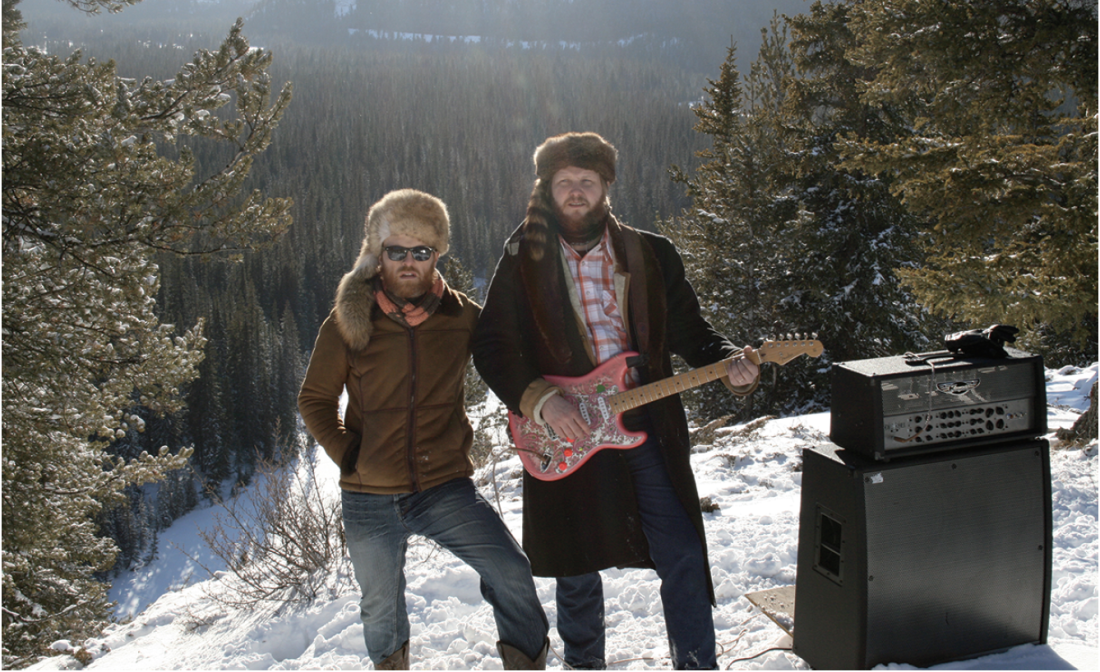Ragnar Kjartansson
Walk into the black cube at Walter Phillips Gallery and plunge into banjo, electric guitar and a grand piano dropped onto the frozen Lake Minnewanka. Who knew, but whacked-out hillbilly music played by Norsemen in coonskin caps seems to fit the bill perfectly in this idyllic alpine preserve of contemporary art.
The End is a beguiling five-channel video installation by modern Renaissance man Ragnar Kjartansson, Iceland’s recent entry to the Venice Biennale. His work was produced at the Banff Centre in 2009 when Kjartansson jammed with colleague David Pór Jónsson in five frigid Rocky mountain locations. The videos document each continuous half-hour musical take. Then they’re synched and projected around the gallery to create an immersive mash of disconnect, yearning, inauthenticity, pathos and, finally, a lovingly rendered ode to the sublime.
The End is also the title of Kjartansson’s six-month performance in Venice where Iceland’s rented venue overlooking the Grand Canal became his studio. No longer housed in Alvar Aalto’s quirky pavilion on the Arsenale grounds, the gorgeously distressed Palazzo Michiel, or Dal Brusà, is an 18th-century renovation of a fire-damaged gothic building. The Iceland pavilion occupied the main entrance hall on the ground floor, which is prone to flooding. Although there were no incidents, Kjartansson is said to have relished this prospect. The artist played the part of an artist—smoking, drinking, playing guitar and obsessively painting his beautiful, languid male model. Over-romantic to be sure, and with the titular backdrop of death and finality to bracket the whole affair, Kjartansson clearly sowed his seeds with the tragic.
While the apparently antithetical backdrops for the two parts of The End are easily construed as natural and cultural or pure and tainted, they are both sublime. Expressing fears that his work might be overwhelmed by the grandeur of the Venetian palazzo, or that his initial concept was weak, he opted to give himself over and “embrace the space.” This kind of self-confident, improvisational approach marks his work as essentially performative.

Ragnar Kjartansson and Davíð Þór Jónsson, production shot of The End, 2009. Photograph: Tatiana Mellema. Courtesy the artist, Luhring Augustine, New York and i8 Gallery, Reykjavik.
A willingness to take leaps of faith, bet on himself, a forthrightness in his shortcomings and an acceptance that he will inevitably, sometimes fail make Ragnar Kjartansson hard not to like. The thing is, he can pull it off. As lead singer of the former electro-glam rock band Trabant (after the East German car), Kjartansson can work the decisive moment. His parents are actors, and he was brought up with that intuitive understanding of the now that performers nourish.
In 2005, as part of the Reykjavík Arts Festival, he staged The Great Unrest, an “installation and constant performance” in an abandoned old dancehall in Dagsbrún, the “nowhere of Iceland,” about an hour and a half from the capital. He inhabited the dishevelled ruin for 12 hours a day, playing the part of a depleted, world-weary knight. Donning cheap makeup and costume, the artist repeated blues laments on his guitar, installed old record players, broken cassette recorders, fragments of poetry and props around the building, which was easily identified from the road outside by the painted flames licking out the windows. By the end of the festival, the deserted dancehall and its past merriments had been revivified as a picturesque and slightly ominous scene of enchanted ruin. For Kjartansson, though, it functioned primarily as a transient and ultimately ephemeral catalyst of the moment: a performance.
Although The Great Unrest helped make his reputation both in Iceland and abroad, he remarked in an interview some years later that he regretted showing video documents of it in an exhibition. “And something about it was not working; it somehow destroyed the story. The piece had become a legend to my own eyes, and then when I saw it in all its nakedness, it was just an art piece, you know.” This faith in the power of the moment might be construed as a slacker’s sensibility, but it really points to Kjartansson’s personal strength as an artist and roots him in the modern camp of improvisation. Although the great number of paintings produced in Venice were shown at Hafnarborg—The Hafnarfjördur Center of Culture and Fine Art, near Reykjavík—and he says he wants to be a painter, the riff is his thing and it guides his artistic approach throughout.
In correspondence leading up to Venice, Kjartansson called himself a “postmodern bastardo” and lamented his lack of “original thought.” However, his audacious romanticism and wholehearted dedication (a work ethic obscured by dandyism) save him from ever sinking into facile cynicism. Nicolas Bourriaud quipped, “What really good artists do is to create a model for a possible world, and possible bits of worlds.” This humbled notion of utopia (or micro-utopia in Bourriaud’s lexicon) depends no less on the clean-slate, no-place that was the precondition for Haussmann’s or Le Corbusier’s schemes. It’s just that today with artists like Ragnar Kjartansson, the corrective bulldozer is replaced by the melancholic aftermath of catastrophe. ❚
“Ragnar Kjartansson: The End” was exhibited at the Walter Phillips Gallery in Banff from January 30 to April 18, 2010.
Marcus Miller has worked across Canada as a curator, writer, artist and teacher.

